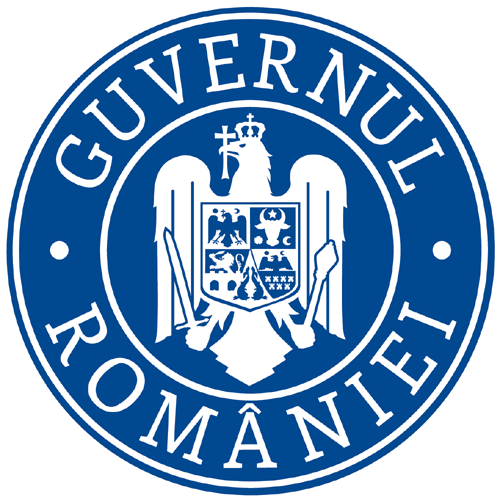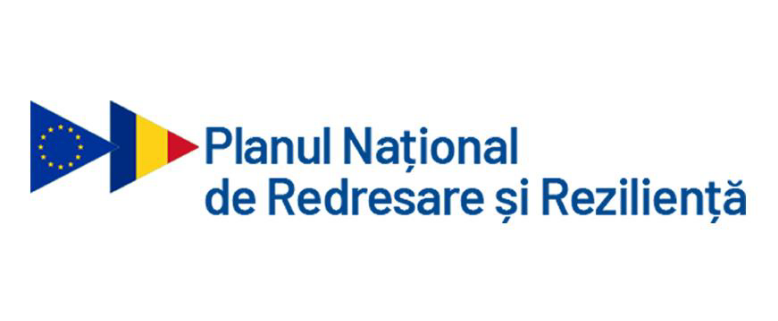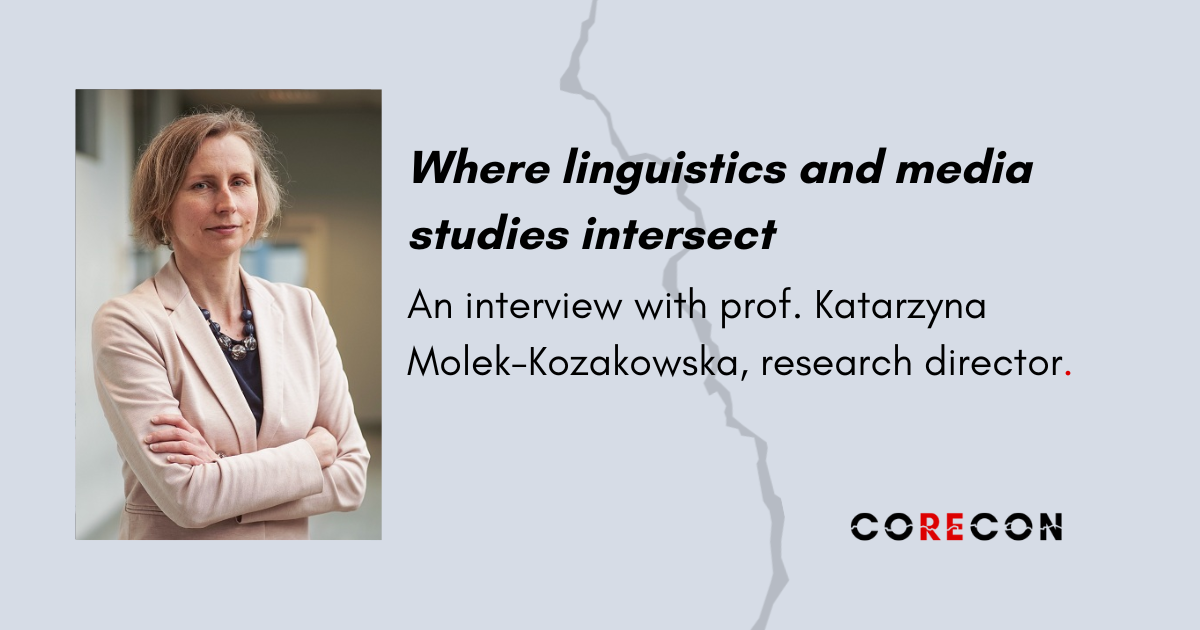Ion Surdu, a journalist at Turnul Sfatului, a local online newspaper in Sibiu is interviewing Prof. Katarzyna Molek-Kozakowska, the director of a recently initiated research project at University of Lucian Blaga in Sibiu. The version of the interview in Romanian can be found here.
Ion Surdu: Katarzyna Molek-Kozakowska is a professor of linguistics and communication and the head of the English Department at the Institute of Linguistics of the University of Opole in Poland. Her university, as well as University of Lucian Blaga in Sibiu, took part in the European University Initiative and joined FORTHEM Alliance – a consortium of 9 universities across Europe that have committed to undertaking joint educational, research and outreach activities. Basing on this common institutional foundation, linguists and communication scholars of the two universities ideated and planned joint research. One successful outcome of this cooperation is the CORECON project initiated in spring 2024 at ULBS. Professor Molek-Kozakowska, please, tell us briefly about the CORECON project: what will it be about, how will it proceed, and what will be the outcome?
Katarzyna Molek-Kozakowska: CORECON is an acronym for “The coverage and reception of the Russian-Ukrainian conflict in Polish, Romanian and English-language media: A comparative critical discourse study with recommendations for journalism training”. ULBS has invited me to oversee the research design and implementation of this comparative study based on the ongoing national and global media coverages of the conflict. While academics have already published smaller scale studies on how individual outlets, or national or local media, have reacted to the Russian invasion of Ukraine, the added value of this project is basically to draw on what has been done in order to capture and quantify larger scale patterns in the coverage of the conflict and to bring the selected media outlets, linguistic patters or issue-specific framings into meaningful comparisons.
We are currently building three separate corpuses of media texts with at least 3,000 texts in each. The ones I’m responsible for are in Polish and English. In the Polish research group we have developed a protocol for corpus compilation that includes not only mainstream informational media, but also very popular social media influencers and political bloggers who have contributed to shaping the understanding of this conflict through their discourses. We will include textual material, but also transcribe podcasts and audiovisual mediated material for complementarity and in order to be able to work on various genres and formats.
This is going to be a very diverse, but hopefully representative, corpus of texts in three languages that we will automatically search for patterns with software. After we have identified any correlations and correspondences we need to look closely at specific examples to provide in-depth interpretations, explanations, and if need be, critiques.
IS: What results do you hope to achieve?
KMK: Despite the differences in the national media systems and media landscapes, we hope to align the three corpuses to enable cross-cutting comparisons and come up with interesting observations as to how the different dimensions of the conflict sparked by the Russian invasion have been presented. Thanks to the corpus and computational techniques that we will be using for this project, we may be able to filter texts, genres, representations and identify linguistic patterns and even individual collocations that are more or less typical or prominent, more or less characteristic for the Polish or Romanian language media.
We may be able to capture and evaluate the range of frames used to interpret and evaluate the events, or the changing nature of the coverage following some critical incidents – bombings, offensives, sieges, military aid packages. We expect to have a better insight also on the conflict-related economic and social issues, especially with regard to displacement of refugees, or other tensions that develop as a result of military aggression, especially regarding energy crises, economy or business relations, technology and defense investments.
IS: What period of the war’s coverage will be considered in the project?
KMK: We have promised to track the ongoing media coverage since 2022 until the corpus is saturated or the time for the compilation in the project is over in 2025. However, while the coverage of the war itself is going to be an important part of the project, there are other dimensions of conflict that we want to explore.
The large international research group that is going to work on the project has diverse expertise and might be working on more specific case studies of the coverage. This can include anything from issues of military draft to war crime and from personal narratives of refugees to national identity metaphors. The project is at its onset and more decisions will be taken after the corpus has been compiled.
IS: How many media sources from Romania will be analyzed in the project – whether they are written and/or audiovisual; and whether they concern national and/or local press? What do you know or how familiar are you with the Romanian media landscape?
KMK: This is a decision to be taken by ULBS experts who have been recruited and are managed by prof. Simina Terian-Dan. They have access to analytics and media consumption patterns in Romania and can advise on which outlets to bring to the corpus and in which proportion. They have communicated this to the Polish team during the project kick-off meeting in Sibiu in mid-February 2024 and we are currently aligning the numbers and proportions to make sure we can draw informed and legitimate parallels. What we know for sure is that both our countries media champion a pro-Ukrainian attitude and are seeking to cover the conflict from a perspective of a neighboring country directly impacted by the invasion and facing new challenges in a time of multiple other crises.

IS: It will soon be 2 years since the beginning of the war in Ukraine. What is your general impression – how is the war reflected in the press? And specifically, – how is it mediated in Poland, and in other countries you have followed?
KMK: One may have an impression that most of media recipients have been desensitized to the ongoing brutality and injustice of the war and have developed a coping mechanism to deal with bad news and sense of insecurity. We are aware that, while being strongly pro-Ukrainian, some media consumers have shielded themselves from war coverage and closed themselves in info-bubbles where they follow only the media coverage they enjoy or political positions they agree with. Obviously, each serious political development or highly covered incident is widely mediated in Poland and it is closely followed by Poles when it infringes on the feeling of safety and security, such as any threat, provocation or accidental entering of a rocket missile into the country’s territorial space.
What is unfortunate is that the political elites sometimes use pro-Ukrainian and anti-Russian sentiments to attack their political opponents, ultimately portraying the policies and statements they disagree with as an element of covert Russian propaganda or intervention. If such sensationalist and conspirational tones dominate public debates, ultimately some media consumers become highly polarized, while others simply lose trust in political elites.
What we also want to highlight through our project is that conflict has many faces and is nuanced and complex, and sometimes difficult to comprehend, and the media coverage that is only black and white is not helping people to understand it and to act responsibly. For example, the fact that you object to the fact that the governmental agency run by an openly pro-Ukrainian political party distributes army supply contracts from taxpayers’ money in a non-transparent way does not necessarily make you anti-Ukrainian. However, some highly politicized media outlets and the blogosphere may present it this way. This has led us to design the project in such a way as to come up with recommendations on coverage of conflicts that could be used for journalism trainings and for media education.
IS: In Romania, if one follows the news, reports – especially in the first year of the war – he or she gets the impression that Ukraine is about to win the war and send the Russian troops home. And that “this summer we will be sunbathing in Crimea” – as President Zelensky himself promised last year. Did you get this impression from following the news in a certain environment?
KMK: I personally did not have an impression that this kind of sentiment was anything than morale-boosting, mobilization-driven wishful thinking. But for one reason or another that was a coverage strategy that some media outlets have adopted, perhaps in order not to alienate their viewers or recipients. My understanding is that, especially in commercial media, the last thing you want is to lose your loyal subscriber or viewer, so you keep them paying attention by carefully tailoring your coverage to their expectations and needs, and you keep oscillating between bad news and good news so that people continue to follow your coverage in the hope of resolving the ambiguity.
That is why in the project we will be looking closely at various rhetorical devices and discursive strategies or framing patterns that may be used by powerful communicators to shape the public discourse in ways that align with their interests, both politically and economically.
IS: In Kyiv, a total political control over the media was imposed: there is a centralized news journal under governmental/presidential control. I guess anyone in charge of Ukraine would have needed this. However, don’t you think that this could somehow influence the analysis of media discourse/language in such a project that you will be coordinating at the University in Sibiu? (Considering, in this regard, that a large part of the mainstream press takes the official communications of Ukraine without questioning or further investigating other independent sources about the state of the war/situation on the front)
KMK: In CORECON we are aware that the information that we have about the military dimension of the conflict, as is usually the case with most military operations, is tightly controlled. Professional journalists with experience in covering wars have specific training and follow the guidelines established by their outlets to deal with this issue. But our analyses will be fine-tuned to see how the same issue is reflected in different media via different languages and editorial lines. For example, if we compared Polish, Romanian and English coverage of what happened in Bucha in March 2022, we would learn more about how this incident, massacre or war crime, you name it, has been presented. We could screen the preferred naming patters, frames, evaluations deployed by various media outlets and find out which ideological positions dominate.
But, as said above, the war coverage is only a fraction of what we study here and we will be searching for discursive patterns around other topics too, some of which are not about what happened, but about conflicting opinions and estimates and predictions about what might happen. What linguists do is not to check how the texts they study relate to reality, but how the texts construct and present a certain version of reality (including the possible future realities) to the viewer. We want to study how the word-choice, style, rhetorical devices are shaping the representations that media consumers are likely to assimilate.
IS: Can we discuss in this case about the stereotypical representations of “us” versus “them”, as you observed in the study “Casual, Colloquial, Commonsensical: A News Values Stylistic Analysis of a Populist Newsfeed”. Of course, then being about pro-Trump media messages and the use of populist language, as you explained later in an interview?
KMK: Indeed, one thing that is relatively easy to assimilate and follows a human inclination to think along binary oppositions is the notion of conflict as “us” vs “them.” It is cognitively and linguistically comfortable to go by these simple categories and clear-cut distinctions, because it does not take a lot of time and effort to process incoming information. Some say that our brains are hard-wired to make quick distinctions into friend/enemy, harmless/harmful, useful/useless, etc., otherwise the human race would not have survived.
Language systems have preserved and even sharpened the categories that reproduce these distinctions, but also have resources to further nuance or mitigate them, usually through building semantic complexity or through textual and argumentative operations.
Yet, the social-media dominated news consumption and the informational overload where a lot of items compete for our attention are not conducive to that much sophistication or tolerance of ambiguity. The online media disseminators that I have studied extensively in my previous research rely on technological and linguistic affordances that make it even harder to escape the binary oppositions, for example by classifying issues or people as either “with us” or “against us”. The communicative styles of populists are often based on exploiting the confrontational dichotomy and injecting it with the sense of threat or fear.

IS: Do you think that historical events from the past affect the way a war is covered in the press?
KMK: Past and ongoing conflicts are likely to influence the professional practices of press coverage. We will not take a look back at it in this project but it is almost impossible to study linguistic expressions and metaphors of conflict as if they were not shaped by history and culture. The language we use is a repository of schemas, frames and scripts that have been constantly influencing our shared cognition and social imaginaries.
For example, imagine a business meeting aimed to negotiate a deal. You might hear a comment that one side “brought out some heavy cannons”, “dropped a bomb” on the opponent, “besieged” them with questions or arguments, etc. Expressions like these, especially when repeatedly used in the sensationalist media might give an impression that business negotiations are more brutal than you imagined.
Also if comparisons are drawn with WWII in the Polish media, particularly Hitler, blitzkrieg, the battle of Monte Cassino, the Nazi camp at Auschwitz, or D-Day, they will certainly evoke strong associations and lead the Polish audience to specific interpretations, often by hijacking their emotional responses.
IS: Does it affect the objectivity of the reporting?
KMK: As a linguist specializing in critical discourse analysis of mediated communication, I’m familiar with the controversy around the possibility for human communicators to be “objective”. In this project we might be talking about media neutrality (as opposed to bias), media accountability, social responsibility and ethics (as opposed to propaganda), media independence (as opposed to political affiliation and profit motive), and journalistic codes and standards (as opposed to amateur journalism).
We acknowledge the role of professional journalism in shaping the public discourse of conflict, but we also need to pay attention to the growing number of “non-professional” media voices and popular “niche” discussion spaces, especially hosted by online media platforms and sometimes spilling over to public sphere. The fact that some information is false or detached from reality does not make it unreal – it becomes a real component of the public discourse. That is why fake news and conspiracy theories are being studied in a variety of academic disciplines and projects as ingredients of the public sphere. We might be contributing to this line of research with our project from a linguistic angle.
IS: What are the mistakes journalists make when writing news/articles about the war?
KMK: This is yet to be determined, but as such, establishing this is not really the aim of the project. Also, the project is not so much about individual journalists as it is about the media systems and language systems that we may approach more or less consciously, critically and responsibly.
Linguists and discourse analysists can shed more light on what other researchers take for granted – the language. Many believe that language is a transparent medium for expression and that truth is truth and a lie is a lie no matter what words are chosen. We see that this is not always the case within one language, much less across languages, with the variety of linguistic resources and discursive strategies that can be recruited by skillful communicators to represent reality and make meaning in such a way that it suits their interests better and is more easily assimilated by the recipients.
IS: You explained in that interview that: “The styles of populism vary, but we believe that if voters were paying more attention to devices of language and expression, rhetorical maneuvering or purposeful stylization, there would be less possibility to manipulate them into voting for parties that, in the end, do not serve them well.” But how can people be attentive to expressions and language, when
- on the one hand: the trust in the media is declining and respectively there is a poor media education to support the few sources/newsrooms that do their job well,
- and on the other hand: people really find themselves in the discourses of “populists” combined with the inability to deliver good/popular policies by (those who call themselves) the ruling “democrats”? Where do you see the key in this situation?
KMK: As mentioned above, the project is aiming to call attention to linguistic patterns and discursive strategies that shape our representations of conflict and to maybe spotlight when these representations are not very helpful and conducive to understanding and responsible citizen behavior.
I agree that public schooling could serve citizens better if it included more media education that includes some political economy of the media, some information about the workings of language and visuals in media messages and some about media effects. Sometimes I feel that in modern democracies people have less understanding of what constitutes rhetorical maneuvering and fallacious argumentation than the ancient democracies where rhetoric was part of citizen training. Notwithstanding the growing challenges, our project aims to deliver not only academic publications but also other types of outputs that might be accessible to educators and broader publics to enrich the growing pool of media literacy recommendations and training materials.
IS: Thank you and good luck with the project.





